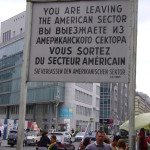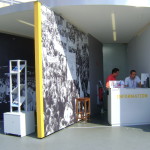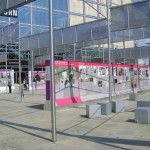 For nearly 30 years, the Berlin Wall was a tangible symbol of human rights suppression. Constructed by the Soviet’s Eastern Bloc in the early 1960s during the Cold War, this onetime barrier no longer exists now having been torn down, chipped away or auctioned off–save for small protected sections that remain.
For nearly 30 years, the Berlin Wall was a tangible symbol of human rights suppression. Constructed by the Soviet’s Eastern Bloc in the early 1960s during the Cold War, this onetime barrier no longer exists now having been torn down, chipped away or auctioned off–save for small protected sections that remain.
Today, the majority site of where the Berlin Wall once stood can be identified throughout the city by a small double row of cobblestones that is pressed into the road and along sidewalks. Thankfully, large sections of the Berlin Wall were donated to museums around the world to give people a deeper understanding of its historical significance, and to help future generations comprehend the sacrifices that so many people made to instill hope for a better tomorrow.
By traveling to various Berlin Wall exhibits throughout the US and abroad, I have gained new insights about the social and political dynamics that changed the world. Moreover, the educational exhibits that accompany each Berlin Wall display are unique within in its own right providing different perspectives on the same issue.
An important contextual theme that I share with my students in my classes is how people can perceive the same issue in different ways guided largely by their personal ways of knowing and cultural lenses. Seeing and learning more about the Berlin Wall in various locations has helped me to better communicate this reality.
To date, I have visited sections of the Berlin Wall located in:
- Berlin (Germany)
- Imperial War Museum in the American Air Museum Hanger at Duxford, Cambridgeshire (England)
- Richard Nixon Presidential Library and Birthplace, Yorba Linda (Califorina)
- Ronald Reagan Presidential Library, Simi Valley (California)
Also shown in one of the photographs below are two small pieces of the Berlin Wall that I obtained in 1990.
- Orginial section of Wall having been chipped away
- Checkpoint Charlie
- Reagan Library exhibit
- Duxford exhibit with friends
- Double row of coublestones marking the wall site in Berlin
- Section of Wall in Nixon Library
- Section of Wall in Nixon Library
- Looking down street towards Checkpoint Charlie
- Nixon Library display
- West Berlin 20th anniversity of the Wall Fall exhibit
- East Berlin 20th Anniversary exhibit
- East Berlin 20th anniversary exhibit
- Standing under Checkpoint Charlie with poster
- Duplicate of display at Reagan Library
- Original sections from Berlin Wall















